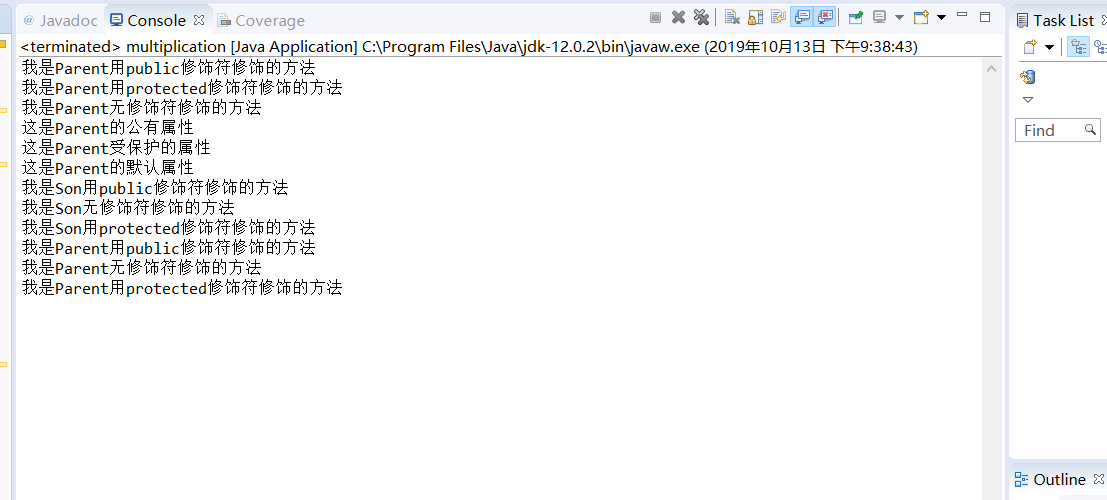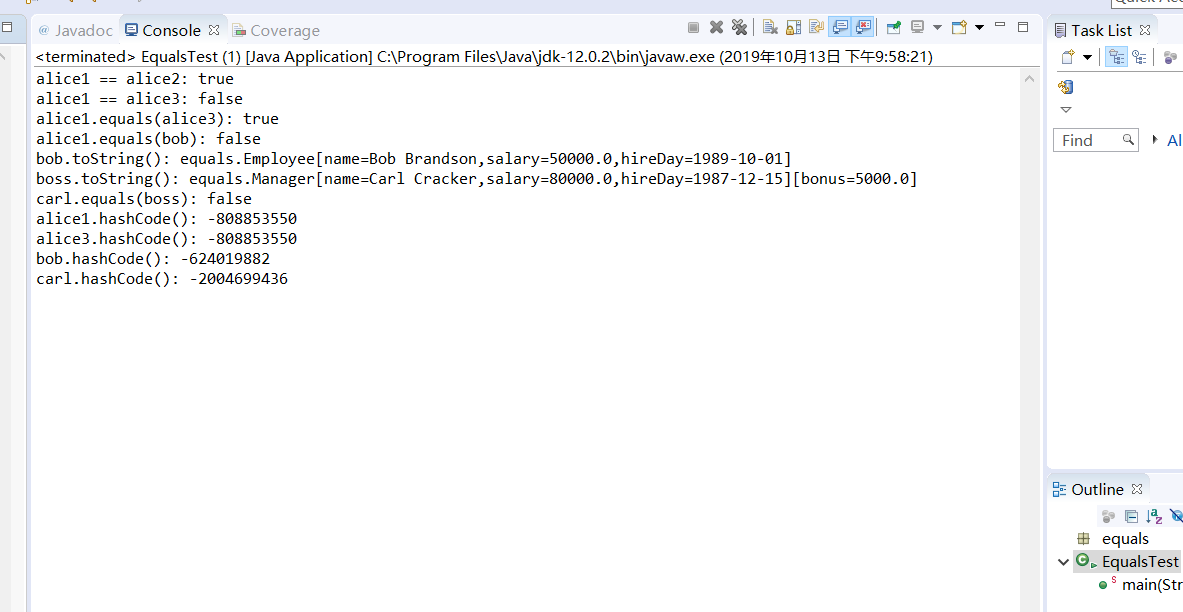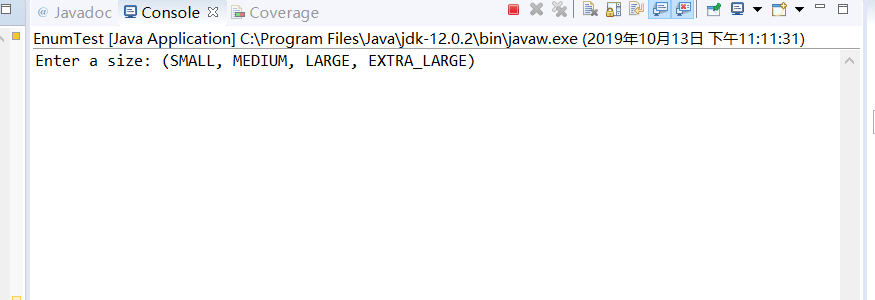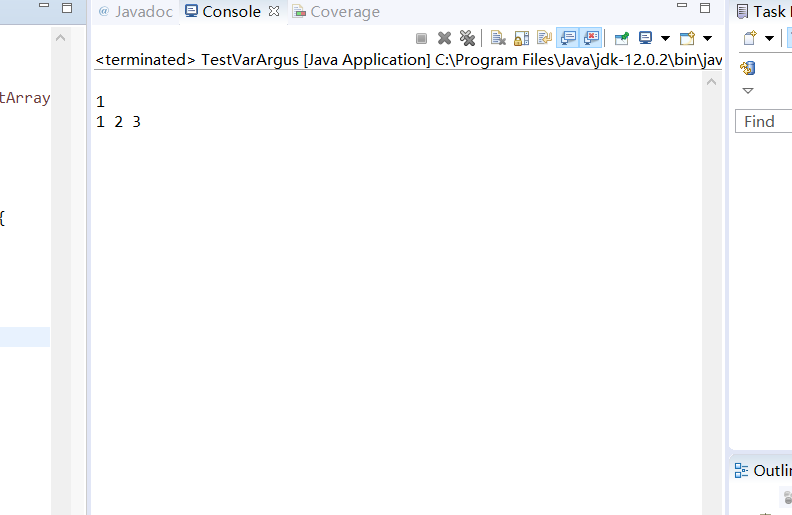201871010114-李岩松《面向对象程序设计(java)》第七周学习总结
|
项目 |
内容 |
|
这个作业属于哪个课程 |
https://www.cnblogs.com/nwnu-daizh/ |
|
这个作业的要求在哪里 |
https://www.cnblogs.com/nwnu-daizh/p/11435127.html |
|
作业学习目标 |
|
实验六 Object类、ArrayList类与枚举类
实验时间 2019-10-11
1、实验目的与要求
(1) 掌握四种访问权限修饰符的使用特点;
(2) 掌握Object类的用途及常用API;
(3) 掌握ArrayList类的定义方法及用法;
(4)掌握枚举类定义方法及用途;
(5)结合本章实验内容,理解继承与多态性两个面向对象程序设计特征,并体会其优点。
2、实验内容和步骤
实验1: 在“System.out.println(...);”语句处按注释要求设计代码替换...,观察代码录入中IDE提示,以验证四种权限修饰符的用法。
- package hello;
- class Parent {
- private String p1 = "这是Parent的私有属性";
- public String p2 = "这是Parent的公有属性";
- protected String p3 = "这是Parent受保护的属性";
- String p4 = "这是Parent的默认属性";
- private void pMethod1() {
- System.out.println("我是Parent用private修饰符修饰的方法");
- }
- public void pMethod2() {
- System.out.println("我是Parent用public修饰符修饰的方法");
- }
- protected void pMethod3() {
- System.out.println("我是Parent用protected修饰符修饰的方法");
- }
- void pMethod4() {
- System.out.println("我是Parent无修饰符修饰的方法");
- }
- }
- class Son extends Parent{
- private String s1 = "这是Son的私有属性";
- public String s2 = "这是Son的公有属性";
- protected String s3 = "这是Son受保护的属性";
- String s4 = "这是Son的默认属性";
- public void sMethod1() {
- System.out.println(p2);
- System.out.println(p3);
- System.out.println(p4);
- //分别尝试显示Parent类的p1、p2、p3、p4值
- System.out.println("我是Son用public修饰符修饰的方法");
- }
- private void sMethod2() {
- System.out.println("我是Son用private修饰符修饰的方法");
- }
- protected void sMethod() {
- System.out.println("我是Son用protected修饰符修饰的方法");
- }
- void sMethod4() {
- System.out.println("我是Son无修饰符修饰的方法");
- }
- }
- public class multiplication {
- public static void main(String[] args) {
- Parent parent=new Parent();
- Son son=new Son();
- //System.out.println();
- parent.pMethod2();//用parent调用parent类的方法
- parent.pMethod3();//
- parent.pMethod4();//
- son.sMethod1();//用son调用son类的方法
- son.sMethod4();
- son.sMethod();
- son.pMethod2();//用son类调用parent类的方法
- son.pMethod4();
- son.pMethod3();
- }
- }
输出结果:
实验2:导入第5章以下示例程序,测试并进行代码注释。
测试程序1:
l 运行教材程序5-8、5-9、5-10,结合程序运行结果理解程序(教材174页-177页);
l 删除程序中Employee类、Manager类中的equals()、hasCode()、toString()方法,背录删除方法,在代码录入中理解类中重写Object父类方法的技术要点。
5-8
- package equals;
- /**
- * This program demonstrates the equals method.
- * @version 1.12 2012-01-26
- * @author Cay Horstmann
- */
- public class EqualsTest
- {
- public static void main(String[] args)
- {
- Employee alice1 = new Employee("Alice Adams", 75000, 1987, 12, 15);
- Employee alice2 = alice1;
- Employee alice3 = new Employee("Alice Adams", 75000, 1987, 12, 15);
- Employee bob = new Employee("Bob Brandson", 50000, 1989, 10, 1);
- System.out.println("alice1 == alice2: " + (alice1 == alice2));
- System.out.println("alice1 == alice3: " + (alice1 == alice3));
- System.out.println("alice1.equals(alice3): " + alice1.equals(alice3));
- System.out.println("alice1.equals(bob): " + alice1.equals(bob));
- System.out.println("bob.toString(): " + bob);
- Manager carl = new Manager("Carl Cracker", 80000, 1987, 12, 15);
- Manager boss = new Manager("Carl Cracker", 80000, 1987, 12, 15);
- boss.setBonus(5000);
- System.out.println("boss.toString(): " + boss);
- System.out.println("carl.equals(boss): " + carl.equals(boss));
- System.out.println("alice1.hashCode(): " + alice1.hashCode());
- System.out.println("alice3.hashCode(): " + alice3.hashCode());
- System.out.println("bob.hashCode(): " + bob.hashCode());
- System.out.println("carl.hashCode(): " + carl.hashCode());
- }
- }
- 5-9
package equals;- import java.time.*;
- import java.util.Objects;
- public class Employee
- {
- private String name;
- private double salary;
- private LocalDate hireDay;
- public Employee(String name, double salary, int year, int month, int day)
- {
- this.name = name;
- this.salary = salary;
- hireDay = LocalDate.of(year, month, day);
- }
- public String getName()
- {
- return name;
- }
- public double getSalary()
- {
- return salary;
- }
- public LocalDate getHireDay()
- {
- return hireDay;
- }
- public void raiseSalary(double byPercent)
- {
- double raise = salary * byPercent / 100;
- salary += raise;
- }
- public boolean equals(Object otherObject)
- {
- // a quick test to see if the objects are identical
- if (this == otherObject) return true;
- // must return false if the explicit parameter is null
- if (otherObject == null) return false;
- // if the classes don't match, they can't be equal
- if (getClass() != otherObject.getClass()) return false;
- // now we know otherObject is a non-null Employee
- Employee other = (Employee) otherObject;
- // test whether the fields have identical values
- return Objects.equals(name, other.name) && salary == other.salary && Objects.equals(hireDay, other.hireDay);
- }
- public int hashCode()
- {
- return Objects.hash(name, salary, hireDay);
- }
- public String toString()
- {
- return getClass().getName() + "[name=" + name + ",salary=" + salary + ",hireDay=" + hireDay
- + "]";
- }
- }
5-10
- package equals;
- import java.time.*;
- import java.util.Objects;
- public class Employee
- {
- private String name;
- private double salary;
- private LocalDate hireDay;
- public Employee(String name, double salary, int year, int month, int day)
- {
- this.name = name;
- this.salary = salary;
- hireDay = LocalDate.of(year, month, day);
- }
- public String getName()
- {
- return name;
- }
- public double getSalary()
- {
- return salary;
- }
- public LocalDate getHireDay()
- {
- return hireDay;
- }
- public void raiseSalary(double byPercent)
- {
- double raise = salary * byPercent / 100;
- salary += raise;
- }
- public boolean equals(Object otherObject)
- {
- // a quick test to see if the objects are identical
- if (this == otherObject) return true;
- // must return false if the explicit parameter is null
- if (otherObject == null) return false;
- // if the classes don't match, they can't be equal
- if (getClass() != otherObject.getClass()) return false;
- // now we know otherObject is a non-null Employee
- Employee other = (Employee) otherObject;
- // test whether the fields have identical values
- return Objects.equals(name, other.name) && salary == other.salary && Objects.equals(hireDay, other.hireDay);
- }
- public int hashCode()
- {
- return Objects.hash(name, salary, hireDay);
- }
- public String toString()
- {
- return getClass().getName() + "[name=" + name + ",salary=" + salary + ",hireDay=" + hireDay
- + "]";
- }
- }
运行结果

总结:Object是所有类的父类,它有很多类对象会用到的方法,例如比较常用的toString 、equals,当你新建xx类时,你可以重写Object已经定义的方法,也可以直接调用Object中的方法,如果你写一个封装的方法,不确定传进来的是什么类型的值,就可以使用Object作为一个笼统类。
测试程序2:
l 在elipse IDE中调试运行程序5-11(教材182页),结合程序运行结果理解程序;
l 掌握ArrayList类的定义及用法;
l 在程序中相关代码处添加新知识的注释;
l 设计适当的代码,测试ArrayList类的set()、get()、remove()、size()等方法的用法。
- package arrayList;
- import java.util.*;
- /**
- * This program demonstrates the ArrayList class.
- * @version 1.11 2012-01-26
- * @author Cay Horstmann
- */
- public class ArrayListTest
- {
- public static void main(String[] args)
- {
- // fill the staff array list with three Employee objects
- ArrayList<Employee> staff = new ArrayList<>();
- staff.add(new Employee("Carl Cracker", 75000, 1987, 12, 15));
- staff.add(new Employee("Harry Hacker", 50000, 1989, 10, 1));
- staff.add(new Employee("Tony Tester", 40000, 1990, 3, 15));
- // 把每个员工的薪资提高5%
- for (Employee e : staff)
- e.raiseSalary(5);
- //打印所有雇员对象的信息
- for (Employee e : staff)
- System.out.println("name=" + e.getName() + ",salary=" + e.getSalary() + ",hireDay="
- + e.getHireDay());
- }
- }
运行结果:

设计适当的代码,测试ArrayList类的set()、get()、remove()、size()等方法的用法
- package arrayList;
- import java.util.*;
- /**
- * This program demonstrates the ArrayList class.
- * @version 1.11 2012-01-26
- * @author Cay Horstmann
- */
- public class ArrayListTest
- {
- public static void main(String[] args)
- {
- // 用三个Employee对象填充staff数组列表
- var staff = new ArrayList<Employee>();
- staff.add(new Employee("Carl Cracker", 75000, 1987, 12, 15));
- staff.add(new Employee("Harry Hacker", 50000, 1989, 10, 1));
- staff.add(new Employee("Tony Tester", 40000, 1990, 3, 15));
- System.out.println(staff.get(1));
- staff.set(1, new Employee("liyansong", 20000, 2018, 10, 10));
- System.out.println(staff.size());
- staff.remove(2);
- // 把每个人的薪水提高5%
- for (Employee e : staff)
- e.raiseSalary(5);
- // 打印所有Employee对象的信息
- for (Employee e : staff)
- System.out.println("name=" + e.getName() + ",salary=" + e.getSalary() + ",hireDay="
- + e.getHireDay());
- }
- }
测试结果:

总结:ArrayList就是传说中的动态数组,动态的增加和减少元素 ,ArrayList内部封装了一个Object类型的数组,从一般的意义来说,它和数组没有本质的差别,
并且可以灵活的设置数组的大小。
测试程序3:
l 编辑、编译、调试运行程序5-12(教材189页),结合运行结果理解程序;
l 掌握枚举类的定义及用法;
l 在程序中相关代码处添加新知识的注释;
l 删除程序中Size枚举类,背录删除代码,在代码录入中掌握枚举类的定义要求。
5-12
- package enums;
- import java.util.*;
- /**
- * This program demonstrates enumerated types.
- * @version 1.0 2004-05-24
- * @author Cay Horstmann
- */
- public class EnumTest
- {
- public static void main(String[] args)
- {
- var in = new Scanner(System.in);
- System.out.print("Enter a size: (SMALL, MEDIUM, LARGE, EXTRA_LARGE) ");
- String input = in.next().toUpperCase();
- Size size = Enum.valueOf(Size.class, input);
- System.out.println("size=" + size);
- System.out.println("abbreviation=" + size.getAbbreviation());
- if (size == Size.EXTRA_LARGE)
- System.out.println("Good job--you paid attention to the _.");
- }
- }
- enum Size
- {
- SMALL("S"), MEDIUM("M"), LARGE("L"), EXTRA_LARGE("XL");
- private Size(String abbreviation) { this.abbreviation = abbreviation; }
- public String getAbbreviation() { return abbreviation; }
- private String abbreviation;
- }
- 运行结果:

总结:枚举是一种特殊的数据类型,之所以特殊是因为它既是一种类(class)类型却又比类型多了些特殊的约束,但是这些约束的存在也造就了枚举类型的简洁,安全性以及便捷性。创建枚举类型要使用enum关键字,隐含了所创建的类型都是java.lang.Enum类的子类(java.lang.Enum是一个抽象类)。
测试程序4:录入以下代码,结合程序运行结果了解方法的可变参数用法:
代码:
- public class TestVarArgus {
- public static void dealArray(int... intArray){
- for (int i : intArray)
- System.out.print(i +" ");
- System.out.println();
- }
- public static void main(String args[]){
- dealArray();
- dealArray(1);
- dealArray(1, 2, 3);
- }
- }
运行结果:

实验:3:编程练习:参照输出样例
- public class Demo {
- public static void main(String[] args) {
- Son son = new Son();
- son.method();
- }
- }
- class Parent {
- Parent() {
- System.out.println("Parent's Constructor without parameter");
- }
- Parent(boolean b) {
- System.out.println("Parent's Constructor with a boolean parameter");
- }
- public void method() {
- System.out.println("Parent's method()");
- }
- }
- class Son extends Parent {
- //补全本类定义
- }
补全程序,使程序输出结果与输出样例一致。
程序运行结果如下:
Parent's Constructor with a boolean parameter
Son's Constructor without parameter
Son's method()
Parent's method()
补全代码:
- package enums;
- public class Demo {
- public static void main(String[] args) {
- Son son = new Son();
- son.method();
- }
- }
- class Parent {
- Parent() {
- System.out.println("Parent's Constructor without parameter");
- }
- Parent(boolean b) {
- System.out.println("Parent's Constructor with a boolean parameter");
- }
- public void method() {
- System.out.println("Parent's method()");
- }
- }
- class Son extends Parent {
- Son()
- {
- super(true);
- }
- public void method() {
- System.out.println("Son's Constructor without parameter");
- System.out.println("Son's method()");
- super.method();
- //补全本类定义
- }
- }
运行结果:

第三部分:总结
通过这周的实验,使我更进一步的理解了继承的相关知识,尤其是对四种权限修饰符的理解,还有Object类的常用API用法;ArrayList类用法与常用API,枚举类使用方法;在本章知识中,继承与多态性两个面向对象程序设计特征,利用已掌握Java语言程序设计知识,通过一次一次的练习,我觉得阅读已有的代码,理解其中的方法,并将其转化为自己的知识,是一种很重要的能力,编程没有捷径,只有不断地训练。
201871010114-李岩松《面向对象程序设计(java)》第七周学习总结的更多相关文章
- 201771010134杨其菊《面向对象程序设计java》第九周学习总结
第九周学习总结 第一部分:理论知识 异常.断言和调试.日志 1.捕获 ...
- 扎西平措 201571030332《面向对象程序设计 Java 》第一周学习总结
<面向对象程序设计(java)>第一周学习总结 正文开头: 项目 内容 这个作业属于哪个课程 https://www.cnblogs.com/nwnu-daizh/ 这个作业的要求在哪里 ...
- 201871010132-张潇潇《面向对象程序设计(java)》第一周学习总结
面向对象程序设计(Java) 博文正文开头 项目 内容 这个作业属于哪个课程 https://www.cnblogs.com/nwnu-daizh/ 这个作业的要求在哪里 https://www.cn ...
- 杨其菊201771010134《面向对象程序设计Java》第二周学习总结
第三章 Java基本程序设计结构 第一部分:(理论知识部分) 本章主要学习:基本内容:数据类型:变量:运算符:类型转换,字符串,输入输出,控制流程,大数值以及数组. 1.基本概念: 1)标识符:由字母 ...
- 201871010124 王生涛《面向对象程序设计JAVA》第一周学习总结
项目 内容 这个作业属于哪个课程 https://www.cnblogs.com/nwnu-daizh/ 这个作业的要求在哪里 https://edu.cnblogs.com/campus/xbsf/ ...
- 201871010115——马北《面向对象程序设计JAVA》第二周学习总结
项目 内容 这个作业属于哪个课程 https://www.cnblogs.com/nwnu-daizh/ 这个作业的要求在哪里 https://www.cnblogs.com/nwnu-daizh/p ...
- 201777010217-金云馨《面向对象程序设计(Java)》第二周学习总结
项目 内容 这个作业属于哪个课程 https://www.cnblogs.com/nwnu-daizh/ 这个作业的要求在哪里 https://www.cnblogs.com/nwnu-daizh/p ...
- 201871010132——张潇潇《面向对象程序设计JAVA》第二周学习总结
项目 内容 这个作业属于哪个课程 https://www.cnblogs.com/nwnu-daizh/ 这个作业的要求在哪里 https://www.cnblogs.com/nwnu-daizh/p ...
- 201771010123汪慧和《面向对象程序设计Java》第二周学习总结
一.理论知识部分 1.标识符由字母.下划线.美元符号和数字组成, 且第一个符号不能为数字.标识符可用作: 类名.变量名.方法名.数组名.文件名等.第二部分:理论知识学习部分 2.关键字就是Java语言 ...
- 201521123061 《Java程序设计》第七周学习总结
201521123061 <Java程序设计>第七周学习总结 1. 本周学习总结 2. 书面作业 ArrayList代码分析 1.1 解释ArrayList的contains源代码 贴上源 ...
随机推荐
- asp.net core 腾讯验证码的接入
asp.net core 腾讯验证码的接入 Intro 之前使用的验证码服务是用的极验验证,而且是比较旧的,好久之前接入的,而且验证码服务依赖 Session,有点不太灵活,后来发现腾讯也有验证码服务 ...
- 一个“Hello World”理解JVM运行时数据区
先上一张JVM体系结构图: 1)运行时数据区:经过编译生成的字节码文件(class文件),由class loader(类加载子系统)加载后交给执行引擎执行.在执行引擎执行的过程中产生的数据会存储在一块 ...
- RF自定义库和关键字
1:在D:\work_software\python\Lib\site-packages 文件夹下, 新建python package文件夹 ,例如我的是TestLibrary 建好后的完整路径:D: ...
- 经典的Redis的主从复制搭建
##### 配置服务器 1).打开redis.conf文件修改 bind 指定的ip地址: 
一篇以python Flask 模版渲染为例子的SSTI注入教学~ 0x01 Flask使用和渲染 这里简化了flask使用和渲染的教程 只把在安全中我们需要关注的部分写出来 来一段最简单的FLASK ...
- 懒要懒到底,能自动的就不要手动,Hibernate正向工程完成Oracle数据库到MySql数据库转换(含字段转换、注释)
需求描述 需求是这样的:因为我们目前的一个老项目是Oracle数据库的,这个库呢,数据库是没有注释的,而且字段名和表名都是大写风格,比如 在代码层面的po呢,以前也是没有任何注释的,但是经过这些年,大 ...
- 《Java并发编程实战》读书笔记-第一部分 基础知识小结
并发技巧清单 可变状态是至关重要的 所有的并发问题都可以归结为如何协调对并发状态的访问.可变状态越少,就越容易确保线程安全性. 尽量将域声明为final类型,除非需要它们是可变的. 不可变对象一定是线 ...
- LeetCode初级算法--动态规划01:爬楼梯
LeetCode初级算法--动态规划01:爬楼梯 搜索微信公众号:'AI-ming3526'或者'计算机视觉这件小事' 获取更多算法.机器学习干货 csdn:https://blog.csdn.net ...
- python学习-类的继承
1.继承的语法 2.多继承 3.override(子类重写父类的方法) 4.子类调用父类中被重写的实例方法 5.使用super函数调用父类的构造方法
- 学习Spring的思考框架
引子 很早之前听同事说:“要开会了.我都知道领导要问什么,就那几板斧.”其实领导之所以为领导,人家问的问题确实很合情合理,甚至可以说一针见血.而之所以能问出来这些合理的问题,就是因为头脑中有自己的思考 ...
